Lactose-free Butter Market
Lactose-free Butter Market Size and Share Forecast Outlook 2025 to 2035
Lactose-free butter market is projected to grow from USD 980.0 million in 2025 to USD 1,520.0 million by 2035, at a CAGR of 4.5%. Salted will dominate with a 60.0% market share, while cow milk will lead the source segment with a 90.0% share.
Lactose-free Butter Market Forecast and Outlook 2025 to 2035
The global lactose-free butter market is projected to grow from USD 980.0 million in 2025 to approximately USD 1,520.0 million by 2035, recording an absolute increase of USD 540.0 million over the forecast period. This translates into a total growth of 55.1%, with the market forecast to expand at a compound annual growth rate (CAGR) of 4.5% between 2025 and 2035.
The overall market size is expected to grow by nearly 1.6X during the same period, supported by increasing prevalence of lactose intolerance, rising health consciousness among consumers, and growing demand for dairy alternatives across the global food and beverage industry.
Quick Stats for Lactose-free Butter Market
- Lactose-free Butter Market Value (2025): USD 980.0 million
- Lactose-free Butter Market Forecast Value (2035): USD 1,520.0 million
- Lactose-free Butter Market Forecast CAGR: 4.5%
- Leading Type in Lactose-free Butter Market: Salted (60.0%)
- Key Growth Regions in Lactose-free Butter Market: North America, Europe, and Asia Pacific
- Key Players in Lactose-free Butter Market: Arla, Lactalis, Fonterra, Valio, Danone, Amul, Savencia, Nestlé, Land O'Lakes, Organic Valley, Saputo, Hochland, Dairy Farmers, FrieslandCampina, Meiji
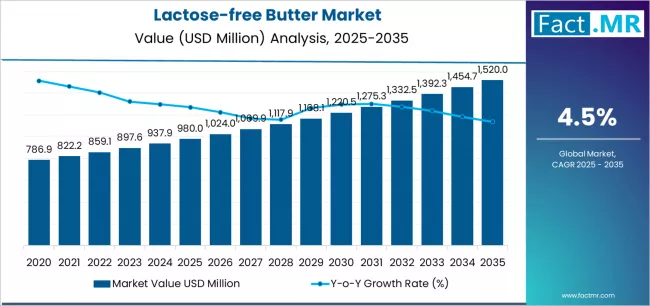
The lactose-free butter market operates within overlapping spheres of medical necessity, lifestyle choice, and culinary tradition where consumer acceptance hinges on achieving sensory equivalence to conventional dairy products. Unlike plant-based alternatives that create entirely new taste profiles, lactose-free butter must deliver identical cooking performance while addressing specific digestive limitations that affect millions of consumers worldwide.
Diagnostic trends significantly influence market expansion through increased awareness of lactose intolerance symptoms and improved medical testing availability. Many consumers discover lactose sensitivity later in life, creating adult-onset demand patterns that differ from childhood food allergies. Self-diagnosis through elimination diets also contributes to market growth as health-conscious individuals experiment with dietary modifications without formal medical confirmation.
Family purchasing dynamics create complex decision-making scenarios where one household member's dietary restriction influences entire family food choices. Parents often adopt lactose-free products for all family members to simplify meal preparation and avoid cross-contamination concerns. These household adoption patterns create larger consumption volumes per customer than individual dietary restrictions might suggest.
Professional culinary acceptance represents a critical market development factor as restaurant chefs and commercial bakers evaluate lactose-free butter for menu applications. Professional kitchens require consistent performance across high-volume cooking operations where ingredient reliability directly affects service quality. Culinary schools increasingly incorporate lactose-free ingredients into training curricula, influencing future professional attitudes toward dairy alternatives.
Manufacturing partnerships between traditional dairy companies and specialized enzyme suppliers create unique competitive dynamics where established brands leverage existing distribution networks while accessing specialized processing expertise. These collaborations enable rapid market entry for major dairy producers while providing technology partners with established customer relationships and manufacturing scale.
Consumer education requirements extend beyond basic product awareness to include cooking technique modifications and storage considerations that may differ from conventional butter. Recipe adaptation guidance helps home cooks achieve desired results while building brand loyalty through successful culinary experiences. Inadequate consumer education often leads to product dissatisfaction and category abandonment.
Marketing innovations, including targeted social media campaigns, influencer endorsements, and recipe-focused content, are expected to accelerate consumer adoption. Additionally, expanding retail availability in supermarkets, specialty stores, and e-commerce platforms enhances accessibility, supporting sustained growth of the lactose-free butter market across diverse demographic and geographic segments.
Between 2025 and 2030, the lactose-free butter market is projected to expand from USD 980.0 million to USD 1,210.0 million, resulting in a value increase of USD 230.0 million, which represents 42.6% of the total forecast growth for the decade. This phase of development will be shaped by rising awareness of lactose intolerance, increasing consumer preference for dairy alternatives, and growing penetration in retail channels across developed markets. Food manufacturers are expanding their product portfolios to address the growing demand for lactose-free dairy alternatives in various culinary applications and foodservice segments.
Lactose-free Butter Market Key Takeaways
| Metric | Value |
|---|---|
| Estimated Value in (2025E) | USD 980.0 million |
| Forecast Value in (2035F) | USD 1,520.0 million |
| Forecast CAGR (2025 to 2035) | 4.5% |
From 2030 to 2035, the market is forecast to grow from USD 1,210.0 million to USD 1,520.0 million, adding another USD 310.0 million, which constitutes 57.4% of the overall ten-year expansion. This period is expected to be characterized by the expansion of product innovation, the integration of advanced dairy processing technologies, and the development of enhanced flavor profiles for lactose-free butter formulations. The growing adoption of clean-label ingredients and premium dairy alternatives will drive demand for high-quality lactose-free butter with improved nutritional specifications and enhanced taste characteristics.
Between 2020 and 2025, the lactose-free butter market experienced moderate expansion, driven by increasing recognition of lactose intolerance prevalence in consumer populations and growing acceptance of dairy alternatives in mainstream food markets. The market developed as consumers recognized the need for lactose-free dairy options to address dietary restrictions and improve digestive comfort. Research and development activities have begun to emphasize the importance of advanced enzyme technologies in achieving better taste and texture in lactose-free butter products.
Why is the Lactose-free Butter Market Growing?
Market expansion is being supported by the increasing prevalence of lactose intolerance among global populations and the corresponding need for high-quality dairy alternatives in culinary applications across consumer and foodservice operations. Modern consumers are increasingly focused on dietary solutions that can improve digestive health, reduce gastrointestinal discomfort, and provide nutritional benefits while meeting taste expectations. The proven efficacy of lactose-free butter in various cooking and baking applications makes it an essential component of comprehensive dietary strategies and kitchen management programs.
The growing emphasis on health-conscious food choices and clean eating optimization is driving demand for lactose-free dairy products that meet nutritional requirements and taste specifications for specialized dietary needs. Consumer preference for natural, enzyme-processed dairy alternatives that can ensure consistent performance and digestive compatibility is creating opportunities for innovative dairy technologies and specialized food formulations. The rising influence of dietary awareness and nutritional education is also contributing to increased adoption of premium-grade lactose-free butter across different culinary applications and food systems requiring enhanced digestive compatibility.
Opportunity Pathways - Lactose-free Butter Market
The lactose-free butter market represents a specialized growth opportunity, expanding from USD 980.0 million in 2025 to USD 1,520.0 million by 2035 at a 4.5% CAGR. As consumers prioritize digestive health, dietary management, and product quality in food preparation processes, lactose-free butter has evolved from a niche dietary product to an essential component enabling culinary applications, nutritional optimization, and multi-stage food preparation across consumer kitchens and specialized dietary applications.
The convergence of health awareness, increasing lactose intolerance recognition, specialized dietary requirements growth, and taste expectations creates momentum in demand. High-quality formulations offering superior taste performance, cost-effective salted varieties balancing flavor with economics, and specialized unsalted variants for baking applications will capture market premiums, while geographic expansion into high-growth Asian markets and emerging market penetration will drive volume leadership. Consumer emphasis on health and taste provides structural support.
- Pathway A - Salted Type Dominance: Leading with 60.0% market share, salted applications drive primary demand through consumer preferences requiring enhanced flavor profiles for table use and cooking applications. Advanced formulations enabling improved taste consistency, reduced processing requirements, and enhanced flavor performance command premium pricing from consumers requiring high-quality taste specifications and culinary satisfaction. Expected revenue pool: USD 588.0-912.0 million.
- Pathway B - Retail Channel Leadership: Dominating with 75.0% market share through an optimal balance of accessibility and consumer convenience, retail serves most consumer applications while meeting product availability requirements. This channel addresses both convenience standards and purchasing considerations, making it the preferred choice for consumers seeking accessible lactose-free dairy alternatives. Opportunity: USD 735.0-1,140.0 million.
- Pathway C - Asian Market Acceleration: India (5.0% CAGR) and China (4.8% CAGR) lead global growth through expanding health awareness, dietary education development, and domestic lactose-free dairy demand. Strategic partnerships with local retailers, distribution network expansion, and supply chain localization enable the expansion of lactose-free technologies in major consumer markets. Geographic expansion upside: USD 196.0-304.0 million.
- Pathway D - Cow Milk Premium Segment: Cow milk-based applications serve traditional dairy preferences requiring authentic butter characteristics for culinary processes. Cow milk formulations supporting complex taste requirements, baking applications, and texture-sensitive processes command significant premiums from quality-focused consumers and specialized culinary facilities. Revenue potential: USD 882.0-1,368.0 million.
- Pathway E - Advanced Processing & Quality Systems: Companies investing in sophisticated enzyme technologies, quality control systems, and taste optimization processes gain competitive advantages through consistent product performance and consumer satisfaction. Advanced capabilities enabling customized formulations and enhanced flavor profiles capture premium consumer partnerships. Technology premium: USD 98.0-152.0 million.
- Pathway F - Supply Chain Optimization & Distribution: Specialized retail networks, cold chain management, and reliable distribution systems create competitive differentiation in consumer markets requiring consistent lactose-free butter availability. Companies offering guaranteed freshness, product quality, and convenient accessibility gain preferred supplier status with health-focused retailers. Supply chain value: USD 59.0-91.0 million.
- Pathway G - Emerging Applications & Market Development: Beyond traditional table use, lactose-free butter in foodservice applications, specialized baking processes, and novel culinary systems represent growth opportunities. Companies developing new applications, supporting culinary innovation, and expanding into adjacent food markets capture incremental demand while diversifying revenue streams. Emerging opportunity: USD 39.0-61.0 million.
Segmental Analysis
The market is segmented by type, source, channel, and region. By type, the market is divided into salted and unsalted. Based on source, the market is categorized into cow milk and plant-based/other. By channel, the market is divided into retail and foodservice. Regionally, the market is divided into North America, Europe, Asia Pacific, Latin America, Middle East & Africa.
By Type, Salted Segment Accounts for 60.0% Market Share
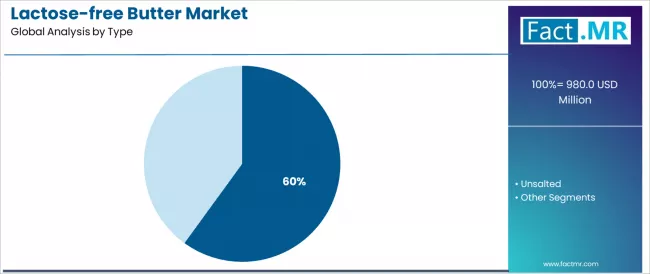
The salted segment is projected to account for 60.0% of the lactose-free butter market in 2025, reaffirming its position as the category's dominant type. Consumers increasingly recognize the optimal balance of flavor and culinary versatility offered by salted lactose-free butter for most table applications, particularly in cooking and food preparation processes. This type addresses both taste requirements and functional considerations while providing enhanced flavor across diverse culinary applications.
This type forms the foundation of most consumer protocols for dairy replacement applications, as it represents the most widely accepted and commercially viable level of flavor enhancement in the industry. Taste standards and extensive consumer testing continue to strengthen confidence in salted lactose-free butter formulations among retail and foodservice providers. With increasing recognition of the taste-functionality optimization requirements in dairy alternatives, salted systems align with both culinary performance and consumer satisfaction goals, making them the central growth driver of comprehensive dietary replacement strategies.
By Source, Cow Milk Segment Accounts for 90.0% Market Share
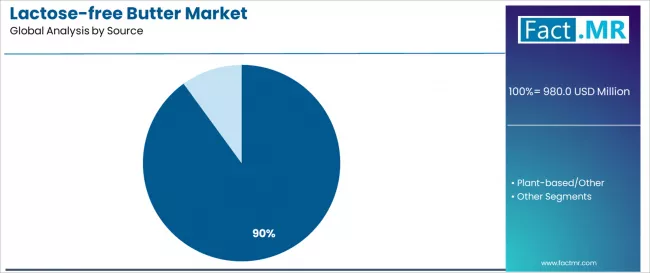
Cow milk is projected to represent 90.0% of lactose-free butter demand in 2025, underscoring its role as the primary source segment driving market adoption and growth. Consumers recognize that traditional dairy requirements, including authentic butter taste, familiar texture characteristics, and proven nutritional profiles, often require cow milk-based lactose-free butter that plant-based alternatives cannot adequately provide. Cow milk-based lactose-free butter offers enhanced taste authenticity and nutritional equivalence in dairy replacement applications.
The segment is supported by the growing complexity of consumer taste expectations, requiring authentic dairy characteristics, and the increasing recognition that traditional dairy processing technologies can improve product acceptance and culinary outcomes. Additionally, consumers are increasingly adopting taste-based purchasing guidelines that recommend cow milk-based lactose-free butter for optimal culinary performance and nutritional benefits. As understanding of dairy alternatives advances and consumer requirements become more demanding, cow milk-based lactose-free butter will continue to play a crucial role in comprehensive dietary management strategies within the consumer market.
By Channel, Retail Segment Accounts for 75.0% Market Share
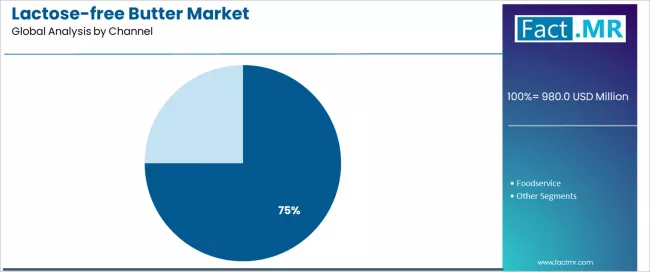
Retail applications are projected to represent 75.0% of lactose-free butter demand in 2025, demonstrating their critical role as the primary distribution segment driving market expansion and adoption. Consumers recognize that retail accessibility requirements, including convenient purchasing options, product availability needs, and household consumption patterns, often require retail distribution channels that foodservice operations cannot adequately provide. Retail lactose-free butter offers enhanced consumer access and purchase convenience in household dairy replacement applications.
What are the Drivers, Restraints, and Key Trends of the Lactose-free Butter Market?
The lactose-free butter market is advancing steadily due to increasing recognition of lactose intolerance prevalence and growing demand for high-quality dairy alternatives across the consumer and foodservice sectors. However, the market faces challenges, including complex processing requirements, potential for taste variations during production and storage, and concerns about supply chain consistency for specialized enzyme treatments. Innovation in dairy processing technologies and customized formulation protocols continues to influence product development and market expansion patterns.
Expansion of Health-Conscious Consumer Behavior and Dietary Awareness
The growing adoption of health-focused dietary practices is enabling the development of more sophisticated lactose-free butter production and quality control systems that can meet stringent taste requirements. Specialized health awareness programs offer comprehensive dietary guidance, including digestive health and nutrition processes that are particularly important for achieving high-quality outcomes in dairy alternative applications. Advanced consumer education provides access to premium dietary services that can optimize nutritional performance and reduce digestive discomfort while maintaining cost-effectiveness for household food budgets.
Integration of Advanced Enzyme Technologies and Processing Systems
Modern dairy organizations are incorporating processing technologies such as real-time enzyme monitoring, automated quality control systems, and taste optimization to enhance lactose-free butter production and distribution processes. These technologies improve product consistency, enable continuous quality monitoring, and provide better coordination between manufacturers and retailers throughout the supply chain cycle. Advanced processing platforms also enable customized taste specifications and early identification of potential quality deviations or processing disruptions, supporting reliable consumer satisfaction.
Analysis of the Lactose-free Butter Market by Key Country

| Country | CAGR (2025-2035) |
|---|---|
| India | 5.0% |
| China | 4.8% |
| USA | 4.4% |
| South Korea | 4.1% |
| Germany | 4.2% |
| Japan | 4.0% |
| France | 3.8% |
The lactose-free butter market is experiencing varied growth globally, with India leading at a 5.0% CAGR through 2035, driven by the expansion of health awareness development, increasing dietary consciousness capabilities, and growing domestic demand for high-quality dairy alternatives.
China follows at 4.8%, supported by consumer education expansion, growing recognition of lactose intolerance importance, and expanding retail accessibility. USA records 4.4% growth, with a focus on developing the health-conscious consumer base and dietary management industries.
South Korea shows 4.1% growth with focus on premium dairy alternative adoption. Germany demonstrates 4.2% growth, emphasizing consumer health awareness expansion and systematic dietary approaches. Japan demonstrate 4.0% growth, emphasizing health consciousness expansion and systematic consumer approaches.
India Demonstrates Growing Market Potential with Health Awareness Development
Revenue from lactose-free butter in India is projected to exhibit robust growth with a CAGR of 5.0% through 2035, driven by ongoing consumer education expansion and increasing recognition of lactose intolerance as essential health component for complex dietary management processes.
The country's expanding health consciousness and growing availability of specialized dairy alternatives are creating significant opportunities for lactose-free butter adoption across both domestic and urban consumer facilities.
Major international and domestic dairy companies are establishing comprehensive retail and distribution networks to serve the growing population of health-conscious consumers and families requiring high-quality dairy alternatives across culinary and dietary applications throughout India's major urban centers.
The Indian government's strategic emphasis on food safety modernization and nutrition advancement is driving substantial investments in specialized dairy processing capabilities. This policy support, combined with the country's large domestic consumer market and expanding health requirements, creates a favorable environment for the lactose-free butter market development. Indian consumers are increasingly focusing on high-value health technologies to improve dietary capabilities, with lactose-free butter representing a key component in this nutritional transformation.
Government initiatives supporting health awareness and nutrition modernization are driving demand for high-quality dairy alternatives throughout major consumer and urban centers, including Mumbai, Delhi, and Chennai regions. Consumer health consciousness expansion and dietary management development are supporting appropriate utilization of lactose-free butter among families and health-conscious consumers nationwide, with particular growth in urban households and specialized dietary services.
China Demonstrates Exceptional Market Potential with Consumer Growth
Revenue from lactose-free butter in China is expanding at a CAGR of 4.8%, supported by increasing health accessibility, growing dietary awareness, and developing consumer market presence across the country's major urban clusters. The country's large consumer sector and increasing recognition of digestive health are driving demand for effective high-quality dairy alternatives in both household and retail applications. International dairy companies and domestic providers are establishing comprehensive distribution channels to serve the growing demand for quality dairy alternatives while supporting the country's position as an emerging health-conscious consumer market.
China's consumer sector continues to benefit from favorable health policies, expanding retail capabilities, and cost-competitive dietary product development. The country's focus on becoming a global consumer health hub is driving investments in specialized dairy technology and nutrition management infrastructure. This development is particularly important for lactose-free butter applications, as consumers seek reliable domestic sources for dietary health technologies to reduce import dependency and improve supply chain security.
Rising awareness about digestive health options and improving retail capabilities are creating opportunities for specialized dairy alternatives across consumer and household settings in major hubs like Beijing, Shanghai, and Guangzhou. Growing health consciousness development and nutrition adoption are supporting increased access to high-quality lactose-free butter among families requiring comprehensive dietary capabilities, particularly in urban households and health-focused organizations.
USA Maintains Consumer Leadership
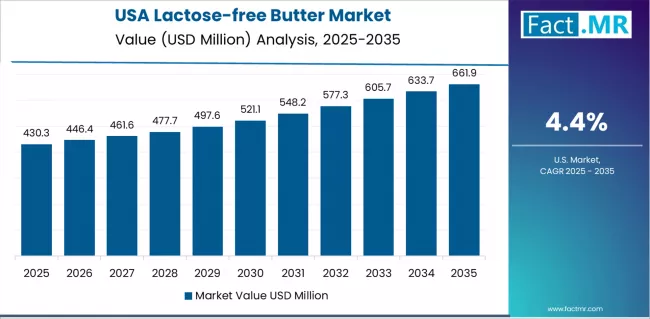
USA's advanced health-conscious consumer market demonstrates sophisticated dietary management deployment with documented lactose-free butter effectiveness in retail networks and consumer households through integration with existing food systems and nutritional infrastructure. The country leverages consumer expertise in health technology and dietary management integration to maintain a 4.4% CAGR through 2035. Consumer centers, including major metropolitan areas, showcase premium product availability where lactose-free butter integrates with comprehensive nutritional information systems and dietary platforms to optimize health outcomes and consumer satisfaction effectiveness.
American consumers prioritize product quality and dietary compliance in food purchasing decisions, creating demand for premium products with advanced features, including taste validation and integration with US nutritional standards. The market benefits from established retail industry infrastructure and a willingness to invest in advanced dietary technologies that provide long-term health benefits and compliance with dietary regulations.
South Korea Emphasizes Advanced Consumer Health
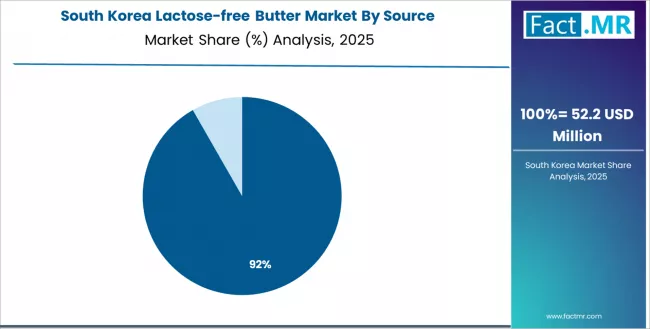
South Korea demonstrates strong market development with a 4.1% CAGR through 2035, driven by advanced consumer health infrastructure and retail preference for technology-integrated lactose-free butter. The country's sophisticated retail ecosystem and high health adoption rates are creating significant opportunities for lactose-free butter adoption across both domestic and health-driven consumer facilities. Based on the provided split data, South Korea's channel breakdown shows Retail at 80.0% and Foodservice at 20.0%, reflecting the country's consumer-focused market and strong retail distribution network.
Korean consumer culture's emphasis on health optimization and beauty-from-within concepts are driving demand for functional dairy alternatives throughout major urban and suburban regions. Advanced digital retail platforms and consumer health awareness campaigns are supporting increased access to premium lactose-free butter among technology-savvy families and health-focused consumers nationwide, with particular growth in online grocery delivery services and specialized health food marketplaces tailored to Korean consumer preferences and dietary management requirements.
Germany Shows Steady Market Growth
Germany demonstrates steady market development with a 4.2% CAGR through 2035, distinguished by consumers' preference for high-quality dairy alternatives that integrate seamlessly with existing dietary patterns and provide reliable long-term nutritional benefits in specialized health applications. The market prioritizes advanced features, including precision processing algorithms, quality validation, and integration with comprehensive nutrition platforms that reflect German consumer expectations for product advancement and health excellence.
Premium focus on quality systems with advanced processing algorithms and high-reliability capabilities for dietary applications requiring exceptional health standards. Integration requirements with existing nutritional information systems and health management platforms supporting comprehensive household nutrition. Emphasis on lactose-free butter reliability and long-term performance in culinary applications with strict taste requirements. Strong preference for locally manufactured products that comply with German food standards and quality regulations.
Japan Emphasizes Quality and Health Excellence
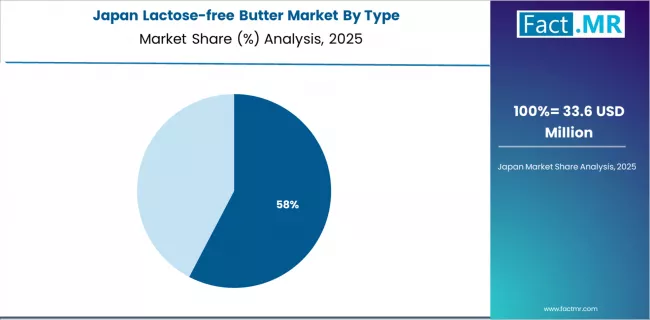
Japan demonstrates steady market development with a 4.0% CAGR through 2035, distinguished by consumers' preference for high-quality dairy alternatives that integrate seamlessly with existing dietary patterns and provide reliable long-term nutritional benefits in specialized health applications. Based on the provided split data, Japan's type breakdown shows Salted lactose-free butter at 65.0% and Unsalted at 35.0%, indicating a strong preference for enhanced flavor profiles while maintaining substantial demand for baking and specialty applications. The market prioritizes advanced features, including precision taste algorithms, quality validation, and integration with comprehensive dietary platforms that reflect Japanese consumer expectations for product advancement and culinary excellence.
Japanese retail giants including Aeon, Ito-Yokado, and Lawson are incorporating advanced lactose-free dairy sections with sophisticated temperature control and quality management systems to serve the growing demand for premium dietary alternatives. The country's aging population and increasing health consciousness are driving substantial investments in specialized nutrition and dietary wellness programs. This demographic shift, combined with Japan's technological advancement culture and precision manufacturing expertise, creates exceptional opportunities for high-quality lactose-free butter adoption across both household consumption and professional food preparation sectors.
France Shows Consistent Market Development
France demonstrates steady market development with a 4.0% CAGR through 2035, driven by consumer preference for premium dairy alternatives and culinary excellence standards. The market benefits from strong culinary traditions and increasing health consciousness among French consumers seeking high-quality lactose-free butter for both cooking and table applications. Major retail chains including Carrefour, Leclerc, and Intermarché are establishing comprehensive lactose-free dairy sections to serve the growing population of health-conscious consumers and culinary enthusiasts requiring premium dairy alternatives across traditional French cooking and modern dietary applications throughout France's major culinary centers.
Government support for food innovation and consumer health initiatives are driving demand for premium dairy alternatives throughout major culinary and retail centers, including Paris, Lyon, and Marseille regions. Consumer culinary consciousness expansion and health-focused cooking development are supporting appropriate utilization of lactose-free butter among households and professional kitchens nationwide, with particular growth in gourmet food preparation and specialized dietary culinary services.
Europe Market Split by Country
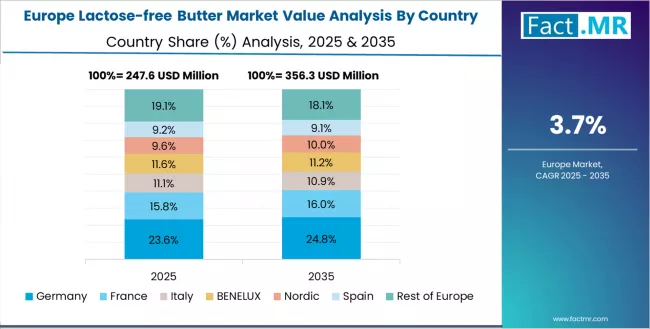
The lactose-free butter market in Europe is projected to grow significantly, with individual country performance varying across the region. Germany is expected to maintain its leadership position with a market value of USD 210.0 million in 2025, supported by its advanced consumer health infrastructure, quality food management capabilities, and strong retail presence throughout major consumer regions.
UK follows with USD 160.0 million in 2025, driven by advanced health protocols, dietary innovation integration, and expanding retail networks serving both domestic and international markets. France holds USD 130.0 million in 2025, supported by culinary infrastructure expansion and growing adoption of high-quality dairy alternatives. Italy commands USD 110.0 million in 2025, while Spain accounts for USD 90.0 million in 2025. The Rest of Europe region, including Nordic countries, Eastern Europe, and smaller Western European markets, holds USD 220.0 million in 2025, representing diverse market opportunities with established consumer health and retail infrastructure capabilities.
Competitive Landscape of the Lactose-free Butter Market
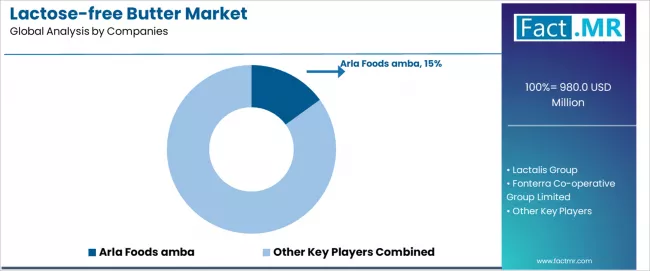
The lactose-free butter market is characterized by competition among established dairy companies, specialty health food companies, and nutrition technology suppliers focused on delivering high-quality, consistent, and reliable dairy alternatives. Companies are investing in processing technology advancement, taste optimization enhancement, strategic partnerships, and consumer education support to deliver effective, efficient, and reliable lactose-free solutions that meet dietary requirements and consumer taste expectations. Product optimization, quality validation protocols, and distribution strategies are central to strengthening product portfolios and market presence.
Arla leads the market with a 15.0% market share, offering comprehensive high-quality lactose-free butter with a focus on taste consistency and nutritional reliability for consumer applications. Lactalis provides specialized dairy systems with emphasis on retail applications and comprehensive technical support services. Fonterra focuses on advanced dairy technologies and customized consumer solutions for lactose-free systems serving global markets. Valio delivers established health-focused systems with strong quality control systems and consumer service capabilities.
Danone operates with a focus on bringing innovative dairy technologies to specialized consumer applications and emerging markets. Amul provides comprehensive lactose-free product portfolios, including advanced dairy services, across multiple consumer applications and retail distribution processes. Savencia specializes in customized dairy solutions and taste management systems for consumer systems with emphasis on quality compliance. Nestlé provides reliable supply chain solutions and brand expertise to enhance market accessibility and consumer access to essential dairy alternatives.
Key Players in the Lactose-free Butter Market
- Arla Foods amba
- Lactalis Group
- Fonterra Co-operative Group Limited
- Valio Ltd.
- Danone S.A.
- Amul (Gujarat Cooperative Milk Marketing Federation)
- Savencia Fromage & Dairy
- Nestlé S.A.
- Land O’Lakes, Inc.
- Organic Valley (Cropp Cooperative)
- Saputo Inc.
- Hochland SE
- Dairy Farmers of America, Inc.
- Royal FrieslandCampina N.V.
- Meiji Holdings Co., Ltd.
Scope of the Report
| Items | Values |
|---|---|
| Quantitative Units (2025) | USD 980.0 Million |
| Type | Salted, Unsalted |
| Source | Cow Milk, Plant-based/Other |
| Channel | Retail, Foodservice |
| Regions Covered | North America, Europe, Asia Pacific, Latin America, Middle East & Africa |
| Countries Covered | USA, China, Germany, Japan, India, South Korea, France and 40+ countries |
| Key Companies Profiled | Arla, Lactalis, Fonterra, Valio, Danone, Amul, Savencia, and Nestlé |
| Additional Attributes | Dollar sales by type and source, regional demand trends, competitive landscape, consumer preferences for specific lactose-free systems, integration with specialty retail supply chains, innovations in processing technologies, quality monitoring, and taste optimization |
Lactose-free Butter Market by Segments
-
Type:
- Salted
- Unsalted
-
Source:
- Cow Milk
- Plant-based/Other
-
Channel:
- Retail
- Foodservice
-
Region:
- North America
- United States
- Canada
- Mexico
- Europe
- Germany
- United Kingdom
- France
- Italy
- Spain
- Nordic
- BENELUX
- Rest of Europe
- Asia Pacific
- China
- India
- Japan
- South Korea
- ASEAN
- Australia & New Zealand
- Rest of Asia Pacific
- Latin America
- Brazil
- Argentina
- Chile
- Rest of Latin America
- Middle East & Africa
- Kingdom of Saudi Arabia
- Other GCC Countries
- Turkey
- South Africa
- Other African Countries
- Rest of Middle East & Africa
- North America
Table of Content
- Executive Summary
- Global Market Outlook
- Demand to side Trends
- Supply to side Trends
- Technology Roadmap Analysis
- Analysis and Recommendations
- Market Overview
- Market Coverage / Taxonomy
- Market Definition / Scope / Limitations
- Market Background
- Market Dynamics
- Drivers
- Restraints
- Opportunity
- Trends
- Scenario Forecast
- Demand in Optimistic Scenario
- Demand in Likely Scenario
- Demand in Conservative Scenario
- Opportunity Map Analysis
- Product Life Cycle Analysis
- Supply Chain Analysis
- Investment Feasibility Matrix
- Value Chain Analysis
- PESTLE and Porter’s Analysis
- Regulatory Landscape
- Regional Parent Market Outlook
- Production and Consumption Statistics
- Import and Export Statistics
- Market Dynamics
- Global Market Analysis 2020 to 2024 and Forecast, 2025 to 2035
- Historical Market Size Value (USD Million) Analysis, 2020 to 2024
- Current and Future Market Size Value (USD Million) Projections, 2025 to 2035
- Y to o to Y Growth Trend Analysis
- Absolute $ Opportunity Analysis
- Global Market Pricing Analysis 2020 to 2024 and Forecast 2025 to 2035
- Global Market Analysis 2020 to 2024 and Forecast 2025 to 2035, By Type
- Introduction / Key Findings
- Historical Market Size Value (USD Million) Analysis By Type , 2020 to 2024
- Current and Future Market Size Value (USD Million) Analysis and Forecast By Type , 2025 to 2035
- Salted
- Unsalted
- Y to o to Y Growth Trend Analysis By Type , 2020 to 2024
- Absolute $ Opportunity Analysis By Type , 2025 to 2035
- Global Market Analysis 2020 to 2024 and Forecast 2025 to 2035, By Source
- Introduction / Key Findings
- Historical Market Size Value (USD Million) Analysis By Source, 2020 to 2024
- Current and Future Market Size Value (USD Million) Analysis and Forecast By Source, 2025 to 2035
- Cow Milk
- Plant-based/Other
- Y to o to Y Growth Trend Analysis By Source, 2020 to 2024
- Absolute $ Opportunity Analysis By Source, 2025 to 2035
- Global Market Analysis 2020 to 2024 and Forecast 2025 to 2035, By Channel
- Introduction / Key Findings
- Historical Market Size Value (USD Million) Analysis By Channel, 2020 to 2024
- Current and Future Market Size Value (USD Million) Analysis and Forecast By Channel, 2025 to 2035
- Retail
- Foodservice
- Y to o to Y Growth Trend Analysis By Channel, 2020 to 2024
- Absolute $ Opportunity Analysis By Channel, 2025 to 2035
- Global Market Analysis 2020 to 2024 and Forecast 2025 to 2035, By Region
- Introduction
- Historical Market Size Value (USD Million) Analysis By Region, 2020 to 2024
- Current Market Size Value (USD Million) Analysis and Forecast By Region, 2025 to 2035
- North America
- Latin America
- Western Europe
- Eastern Europe
- East Asia
- South Asia and Pacific
- Middle East & Africa
- Market Attractiveness Analysis By Region
- North America Market Analysis 2020 to 2024 and Forecast 2025 to 2035, By Country
- Historical Market Size Value (USD Million) Trend Analysis By Market Taxonomy, 2020 to 2024
- Market Size Value (USD Million) Forecast By Market Taxonomy, 2025 to 2035
- By Country
- USA
- Canada
- Mexico
- By Type
- By Source
- By Channel
- By Country
- Market Attractiveness Analysis
- By Country
- By Type
- By Source
- By Channel
- Key Takeaways
- Latin America Market Analysis 2020 to 2024 and Forecast 2025 to 2035, By Country
- Historical Market Size Value (USD Million) Trend Analysis By Market Taxonomy, 2020 to 2024
- Market Size Value (USD Million) Forecast By Market Taxonomy, 2025 to 2035
- By Country
- Brazil
- Chile
- Rest of Latin America
- By Type
- By Source
- By Channel
- By Country
- Market Attractiveness Analysis
- By Country
- By Type
- By Source
- By Channel
- Key Takeaways
- Western Europe Market Analysis 2020 to 2024 and Forecast 2025 to 2035, By Country
- Historical Market Size Value (USD Million) Trend Analysis By Market Taxonomy, 2020 to 2024
- Market Size Value (USD Million) Forecast By Market Taxonomy, 2025 to 2035
- By Country
- Germany
- UK
- Italy
- Spain
- France
- Nordic
- BENELUX
- Rest of Western Europe
- By Type
- By Source
- By Channel
- By Country
- Market Attractiveness Analysis
- By Country
- By Type
- By Source
- By Channel
- Key Takeaways
- Eastern Europe Market Analysis 2020 to 2024 and Forecast 2025 to 2035, By Country
- Historical Market Size Value (USD Million) Trend Analysis By Market Taxonomy, 2020 to 2024
- Market Size Value (USD Million) Forecast By Market Taxonomy, 2025 to 2035
- By Country
- Russia
- Poland
- Hungary
- Balkan & Baltic
- Rest of Eastern Europe
- By Type
- By Source
- By Channel
- By Country
- Market Attractiveness Analysis
- By Country
- By Type
- By Source
- By Channel
- Key Takeaways
- East Asia Market Analysis 2020 to 2024 and Forecast 2025 to 2035, By Country
- Historical Market Size Value (USD Million) Trend Analysis By Market Taxonomy, 2020 to 2024
- Market Size Value (USD Million) Forecast By Market Taxonomy, 2025 to 2035
- By Country
- China
- Japan
- South Korea
- By Type
- By Source
- By Channel
- By Country
- Market Attractiveness Analysis
- By Country
- By Type
- By Source
- By Channel
- Key Takeaways
- South Asia and Pacific Market Analysis 2020 to 2024 and Forecast 2025 to 2035, By Country
- Historical Market Size Value (USD Million) Trend Analysis By Market Taxonomy, 2020 to 2024
- Market Size Value (USD Million) Forecast By Market Taxonomy, 2025 to 2035
- By Country
- India
- ASEAN
- Australia & New Zealand
- Rest of South Asia and Pacific
- By Type
- By Source
- By Channel
- By Country
- Market Attractiveness Analysis
- By Country
- By Type
- By Source
- By Channel
- Key Takeaways
- Middle East & Africa Market Analysis 2020 to 2024 and Forecast 2025 to 2035, By Country
- Historical Market Size Value (USD Million) Trend Analysis By Market Taxonomy, 2020 to 2024
- Market Size Value (USD Million) Forecast By Market Taxonomy, 2025 to 2035
- By Country
- Kingdom of Saudi Arabia
- Other GCC Countries
- Turkiye
- South Africa
- Other African Union
- Rest of Middle East & Africa
- By Type
- By Source
- By Channel
- By Country
- Market Attractiveness Analysis
- By Country
- By Type
- By Source
- By Channel
- Key Takeaways
- Key Countries Market Analysis
- USA
- Pricing Analysis
- Market Share Analysis, 2024
- By Type
- By Source
- By Channel
- Canada
- Pricing Analysis
- Market Share Analysis, 2024
- By Type
- By Source
- By Channel
- Mexico
- Pricing Analysis
- Market Share Analysis, 2024
- By Type
- By Source
- By Channel
- Brazil
- Pricing Analysis
- Market Share Analysis, 2024
- By Type
- By Source
- By Channel
- Chile
- Pricing Analysis
- Market Share Analysis, 2024
- By Type
- By Source
- By Channel
- Germany
- Pricing Analysis
- Market Share Analysis, 2024
- By Type
- By Source
- By Channel
- UK
- Pricing Analysis
- Market Share Analysis, 2024
- By Type
- By Source
- By Channel
- Italy
- Pricing Analysis
- Market Share Analysis, 2024
- By Type
- By Source
- By Channel
- Spain
- Pricing Analysis
- Market Share Analysis, 2024
- By Type
- By Source
- By Channel
- France
- Pricing Analysis
- Market Share Analysis, 2024
- By Type
- By Source
- By Channel
- India
- Pricing Analysis
- Market Share Analysis, 2024
- By Type
- By Source
- By Channel
- ASEAN
- Pricing Analysis
- Market Share Analysis, 2024
- By Type
- By Source
- By Channel
- Australia & New Zealand
- Pricing Analysis
- Market Share Analysis, 2024
- By Type
- By Source
- By Channel
- China
- Pricing Analysis
- Market Share Analysis, 2024
- By Type
- By Source
- By Channel
- Japan
- Pricing Analysis
- Market Share Analysis, 2024
- By Type
- By Source
- By Channel
- South Korea
- Pricing Analysis
- Market Share Analysis, 2024
- By Type
- By Source
- By Channel
- Russia
- Pricing Analysis
- Market Share Analysis, 2024
- By Type
- By Source
- By Channel
- Poland
- Pricing Analysis
- Market Share Analysis, 2024
- By Type
- By Source
- By Channel
- Hungary
- Pricing Analysis
- Market Share Analysis, 2024
- By Type
- By Source
- By Channel
- Kingdom of Saudi Arabia
- Pricing Analysis
- Market Share Analysis, 2024
- By Type
- By Source
- By Channel
- Turkiye
- Pricing Analysis
- Market Share Analysis, 2024
- By Type
- By Source
- By Channel
- South Africa
- Pricing Analysis
- Market Share Analysis, 2024
- By Type
- By Source
- By Channel
- USA
- Market Structure Analysis
- Competition Dashboard
- Competition Benchmarking
- Market Share Analysis of Top Players
- By Regional
- By Type
- By Source
- By Channel
- Competition Analysis
- Competition Deep Dive
- Arla Foods amba
- Overview
- Product Portfolio
- Profitability by Market Segments (Product/Age /Sales Channel/Region)
- Sales Footprint
- Strategy Overview
- Marketing Strategy
- Product Strategy
- Channel Strategy
- Lactalis Group
- Fonterra Co-operative Group Limited
- Valio Ltd.
- Danone S.A.
- Amul (Gujarat Cooperative Milk Marketing Federation)
- Savencia Fromage & Dairy
- Nestlé S.A.
- Land O’Lakes, Inc.
- Organic Valley (Cropp Cooperative)
- Saputo Inc.
- Hochland SE
- Dairy Farmers of America, Inc.
- Royal FrieslandCampina N.V.
- Meiji Holdings Co., Ltd.
- Arla Foods amba
- Competition Deep Dive
- Assumptions & Acronyms Used
- Research Methodology
List Of Table
- Table 1: Global Market Value (USD Million) Forecast by Region, 2020 to 2035
- Table 2: Global Market Value (USD Million) Forecast by Type , 2020 to 2035
- Table 3: Global Market Value (USD Million) Forecast by Source, 2020 to 2035
- Table 4: Global Market Value (USD Million) Forecast by Channel, 2020 to 2035
- Table 5: North America Market Value (USD Million) Forecast by Country, 2020 to 2035
- Table 6: North America Market Value (USD Million) Forecast by Type , 2020 to 2035
- Table 7: North America Market Value (USD Million) Forecast by Source, 2020 to 2035
- Table 8: North America Market Value (USD Million) Forecast by Channel, 2020 to 2035
- Table 9: Latin America Market Value (USD Million) Forecast by Country, 2020 to 2035
- Table 10: Latin America Market Value (USD Million) Forecast by Type , 2020 to 2035
- Table 11: Latin America Market Value (USD Million) Forecast by Source, 2020 to 2035
- Table 12: Latin America Market Value (USD Million) Forecast by Channel, 2020 to 2035
- Table 13: Western Europe Market Value (USD Million) Forecast by Country, 2020 to 2035
- Table 14: Western Europe Market Value (USD Million) Forecast by Type , 2020 to 2035
- Table 15: Western Europe Market Value (USD Million) Forecast by Source, 2020 to 2035
- Table 16: Western Europe Market Value (USD Million) Forecast by Channel, 2020 to 2035
- Table 17: Eastern Europe Market Value (USD Million) Forecast by Country, 2020 to 2035
- Table 18: Eastern Europe Market Value (USD Million) Forecast by Type , 2020 to 2035
- Table 19: Eastern Europe Market Value (USD Million) Forecast by Source, 2020 to 2035
- Table 20: Eastern Europe Market Value (USD Million) Forecast by Channel, 2020 to 2035
- Table 21: East Asia Market Value (USD Million) Forecast by Country, 2020 to 2035
- Table 22: East Asia Market Value (USD Million) Forecast by Type , 2020 to 2035
- Table 23: East Asia Market Value (USD Million) Forecast by Source, 2020 to 2035
- Table 24: East Asia Market Value (USD Million) Forecast by Channel, 2020 to 2035
- Table 25: South Asia and Pacific Market Value (USD Million) Forecast by Country, 2020 to 2035
- Table 26: South Asia and Pacific Market Value (USD Million) Forecast by Type , 2020 to 2035
- Table 27: South Asia and Pacific Market Value (USD Million) Forecast by Source, 2020 to 2035
- Table 28: South Asia and Pacific Market Value (USD Million) Forecast by Channel, 2020 to 2035
- Table 29: Middle East & Africa Market Value (USD Million) Forecast by Country, 2020 to 2035
- Table 30: Middle East & Africa Market Value (USD Million) Forecast by Type , 2020 to 2035
- Table 31: Middle East & Africa Market Value (USD Million) Forecast by Source, 2020 to 2035
- Table 32: Middle East & Africa Market Value (USD Million) Forecast by Channel, 2020 to 2035
List Of Figures
- Figure 1: Global Market Pricing Analysis
- Figure 2: Global Market Value (USD Million) Forecast 2020-2035
- Figure 3: Global Market Value Share and BPS Analysis by Type , 2025 and 2035
- Figure 4: Global Market Y to o to Y Growth Comparison by Type , 2025-2035
- Figure 5: Global Market Attractiveness Analysis by Type
- Figure 6: Global Market Value Share and BPS Analysis by Source, 2025 and 2035
- Figure 7: Global Market Y to o to Y Growth Comparison by Source, 2025-2035
- Figure 8: Global Market Attractiveness Analysis by Source
- Figure 9: Global Market Value Share and BPS Analysis by Channel, 2025 and 2035
- Figure 10: Global Market Y to o to Y Growth Comparison by Channel, 2025-2035
- Figure 11: Global Market Attractiveness Analysis by Channel
- Figure 12: Global Market Value (USD Million) Share and BPS Analysis by Region, 2025 and 2035
- Figure 13: Global Market Y to o to Y Growth Comparison by Region, 2025-2035
- Figure 14: Global Market Attractiveness Analysis by Region
- Figure 15: North America Market Incremental Dollar Opportunity, 2025-2035
- Figure 16: Latin America Market Incremental Dollar Opportunity, 2025-2035
- Figure 17: Western Europe Market Incremental Dollar Opportunity, 2025-2035
- Figure 18: Eastern Europe Market Incremental Dollar Opportunity, 2025-2035
- Figure 19: East Asia Market Incremental Dollar Opportunity, 2025-2035
- Figure 20: South Asia and Pacific Market Incremental Dollar Opportunity, 2025-2035
- Figure 21: Middle East & Africa Market Incremental Dollar Opportunity, 2025-2035
- Figure 22: North America Market Value Share and BPS Analysis by Country, 2025 and 2035
- Figure 23: North America Market Value Share and BPS Analysis by Type , 2025 and 2035
- Figure 24: North America Market Y to o to Y Growth Comparison by Type , 2025-2035
- Figure 25: North America Market Attractiveness Analysis by Type
- Figure 26: North America Market Value Share and BPS Analysis by Source, 2025 and 2035
- Figure 27: North America Market Y to o to Y Growth Comparison by Source, 2025-2035
- Figure 28: North America Market Attractiveness Analysis by Source
- Figure 29: North America Market Value Share and BPS Analysis by Channel, 2025 and 2035
- Figure 30: North America Market Y to o to Y Growth Comparison by Channel, 2025-2035
- Figure 31: North America Market Attractiveness Analysis by Channel
- Figure 32: Latin America Market Value Share and BPS Analysis by Country, 2025 and 2035
- Figure 33: Latin America Market Value Share and BPS Analysis by Type , 2025 and 2035
- Figure 34: Latin America Market Y to o to Y Growth Comparison by Type , 2025-2035
- Figure 35: Latin America Market Attractiveness Analysis by Type
- Figure 36: Latin America Market Value Share and BPS Analysis by Source, 2025 and 2035
- Figure 37: Latin America Market Y to o to Y Growth Comparison by Source, 2025-2035
- Figure 38: Latin America Market Attractiveness Analysis by Source
- Figure 39: Latin America Market Value Share and BPS Analysis by Channel, 2025 and 2035
- Figure 40: Latin America Market Y to o to Y Growth Comparison by Channel, 2025-2035
- Figure 41: Latin America Market Attractiveness Analysis by Channel
- Figure 42: Western Europe Market Value Share and BPS Analysis by Country, 2025 and 2035
- Figure 43: Western Europe Market Value Share and BPS Analysis by Type , 2025 and 2035
- Figure 44: Western Europe Market Y to o to Y Growth Comparison by Type , 2025-2035
- Figure 45: Western Europe Market Attractiveness Analysis by Type
- Figure 46: Western Europe Market Value Share and BPS Analysis by Source, 2025 and 2035
- Figure 47: Western Europe Market Y to o to Y Growth Comparison by Source, 2025-2035
- Figure 48: Western Europe Market Attractiveness Analysis by Source
- Figure 49: Western Europe Market Value Share and BPS Analysis by Channel, 2025 and 2035
- Figure 50: Western Europe Market Y to o to Y Growth Comparison by Channel, 2025-2035
- Figure 51: Western Europe Market Attractiveness Analysis by Channel
- Figure 52: Eastern Europe Market Value Share and BPS Analysis by Country, 2025 and 2035
- Figure 53: Eastern Europe Market Value Share and BPS Analysis by Type , 2025 and 2035
- Figure 54: Eastern Europe Market Y to o to Y Growth Comparison by Type , 2025-2035
- Figure 55: Eastern Europe Market Attractiveness Analysis by Type
- Figure 56: Eastern Europe Market Value Share and BPS Analysis by Source, 2025 and 2035
- Figure 57: Eastern Europe Market Y to o to Y Growth Comparison by Source, 2025-2035
- Figure 58: Eastern Europe Market Attractiveness Analysis by Source
- Figure 59: Eastern Europe Market Value Share and BPS Analysis by Channel, 2025 and 2035
- Figure 60: Eastern Europe Market Y to o to Y Growth Comparison by Channel, 2025-2035
- Figure 61: Eastern Europe Market Attractiveness Analysis by Channel
- Figure 62: East Asia Market Value Share and BPS Analysis by Country, 2025 and 2035
- Figure 63: East Asia Market Value Share and BPS Analysis by Type , 2025 and 2035
- Figure 64: East Asia Market Y to o to Y Growth Comparison by Type , 2025-2035
- Figure 65: East Asia Market Attractiveness Analysis by Type
- Figure 66: East Asia Market Value Share and BPS Analysis by Source, 2025 and 2035
- Figure 67: East Asia Market Y to o to Y Growth Comparison by Source, 2025-2035
- Figure 68: East Asia Market Attractiveness Analysis by Source
- Figure 69: East Asia Market Value Share and BPS Analysis by Channel, 2025 and 2035
- Figure 70: East Asia Market Y to o to Y Growth Comparison by Channel, 2025-2035
- Figure 71: East Asia Market Attractiveness Analysis by Channel
- Figure 72: South Asia and Pacific Market Value Share and BPS Analysis by Country, 2025 and 2035
- Figure 73: South Asia and Pacific Market Value Share and BPS Analysis by Type , 2025 and 2035
- Figure 74: South Asia and Pacific Market Y to o to Y Growth Comparison by Type , 2025-2035
- Figure 75: South Asia and Pacific Market Attractiveness Analysis by Type
- Figure 76: South Asia and Pacific Market Value Share and BPS Analysis by Source, 2025 and 2035
- Figure 77: South Asia and Pacific Market Y to o to Y Growth Comparison by Source, 2025-2035
- Figure 78: South Asia and Pacific Market Attractiveness Analysis by Source
- Figure 79: South Asia and Pacific Market Value Share and BPS Analysis by Channel, 2025 and 2035
- Figure 80: South Asia and Pacific Market Y to o to Y Growth Comparison by Channel, 2025-2035
- Figure 81: South Asia and Pacific Market Attractiveness Analysis by Channel
- Figure 82: Middle East & Africa Market Value Share and BPS Analysis by Country, 2025 and 2035
- Figure 83: Middle East & Africa Market Value Share and BPS Analysis by Type , 2025 and 2035
- Figure 84: Middle East & Africa Market Y to o to Y Growth Comparison by Type , 2025-2035
- Figure 85: Middle East & Africa Market Attractiveness Analysis by Type
- Figure 86: Middle East & Africa Market Value Share and BPS Analysis by Source, 2025 and 2035
- Figure 87: Middle East & Africa Market Y to o to Y Growth Comparison by Source, 2025-2035
- Figure 88: Middle East & Africa Market Attractiveness Analysis by Source
- Figure 89: Middle East & Africa Market Value Share and BPS Analysis by Channel, 2025 and 2035
- Figure 90: Middle East & Africa Market Y to o to Y Growth Comparison by Channel, 2025-2035
- Figure 91: Middle East & Africa Market Attractiveness Analysis by Channel
- Figure 92: Global Market - Tier Structure Analysis
- Figure 93: Global Market - Company Share Analysis
- FAQs -
How big is the lactose-free butter market in 2025?
The global lactose-free butter market is estimated to be valued at USD 980.0 million in 2025.
What will be the size of lactose-free butter market in 2035?
The market size for the lactose-free butter market is projected to reach USD 1,520.0 million by 2035.
How much will be the lactose-free butter market growth between 2025 and 2035?
The lactose-free butter market is expected to grow at a 4.5% CAGR between 2025 and 2035.
What are the key product types in the lactose-free butter market?
The key product types in lactose-free butter market are salted and unsalted.
Which source segment to contribute significant share in the lactose-free butter market in 2025?
In terms of source, cow milk segment to command 90.0% share in the lactose-free butter market in 2025.